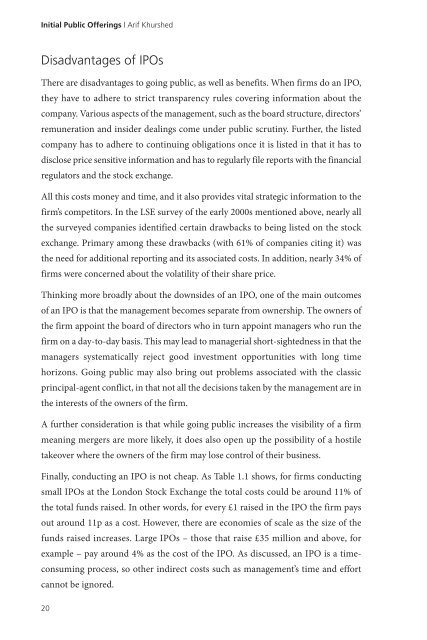Read a PDF Sample of Initial Public Offerings - Harriman House
Read a PDF Sample of Initial Public Offerings - Harriman House
Read a PDF Sample of Initial Public Offerings - Harriman House
Create successful ePaper yourself
Turn your PDF publications into a flip-book with our unique Google optimized e-Paper software.
<strong>Initial</strong> <strong>Public</strong> <strong>Offerings</strong> | Arif Khurshed<br />
Disadvantages <strong>of</strong> IPOs<br />
There are disadvantages to going public, as well as benefits. When firms do an IPO,<br />
they have to adhere to strict transparency rules covering information about the<br />
company. Various aspects <strong>of</strong> the management, such as the board structure, directors’<br />
remuneration and insider dealings come under public scrutiny. Further, the listed<br />
company has to adhere to continuing obligations once it is listed in that it has to<br />
disclose price sensitive information and has to regularly file reports with the financial<br />
regulators and the stock exchange.<br />
All this costs money and time, and it also provides vital strategic information to the<br />
firm’s competitors. In the LSE survey <strong>of</strong> the early 2000s mentioned above, nearly all<br />
the surveyed companies identified certain drawbacks to being listed on the stock<br />
exchange. Primary among these drawbacks (with 61% <strong>of</strong> companies citing it) was<br />
the need for additional reporting and its associated costs. In addition, nearly 34% <strong>of</strong><br />
firms were concerned about the volatility <strong>of</strong> their share price.<br />
Thinking more broadly about the downsides <strong>of</strong> an IPO, one <strong>of</strong> the main outcomes<br />
<strong>of</strong> an IPO is that the management becomes separate from ownership. The owners <strong>of</strong><br />
the firm appoint the board <strong>of</strong> directors who in turn appoint managers who run the<br />
firm on a day-to-day basis. This may lead to managerial short-sightedness in that the<br />
managers systematically reject good investment opportunities with long time<br />
horizons. Going public may also bring out problems associated with the classic<br />
principal-agent conflict, in that not all the decisions taken by the management are in<br />
the interests <strong>of</strong> the owners <strong>of</strong> the firm.<br />
A further consideration is that while going public increases the visibility <strong>of</strong> a firm<br />
meaning mergers are more likely, it does also open up the possibility <strong>of</strong> a hostile<br />
takeover where the owners <strong>of</strong> the firm may lose control <strong>of</strong> their business.<br />
Finally, conducting an IPO is not cheap. As Table 1.1 shows, for firms conducting<br />
small IPOs at the London Stock Exchange the total costs could be around 11% <strong>of</strong><br />
the total funds raised. In other words, for every £1 raised in the IPO the firm pays<br />
out around 11p as a cost. However, there are economies <strong>of</strong> scale as the size <strong>of</strong> the<br />
funds raised increases. Large IPOs – those that raise £35 million and above, for<br />
example – pay around 4% as the cost <strong>of</strong> the IPO. As discussed, an IPO is a timeconsuming<br />
process, so other indirect costs such as management’s time and effort<br />
cannot be ignored.<br />
20
















